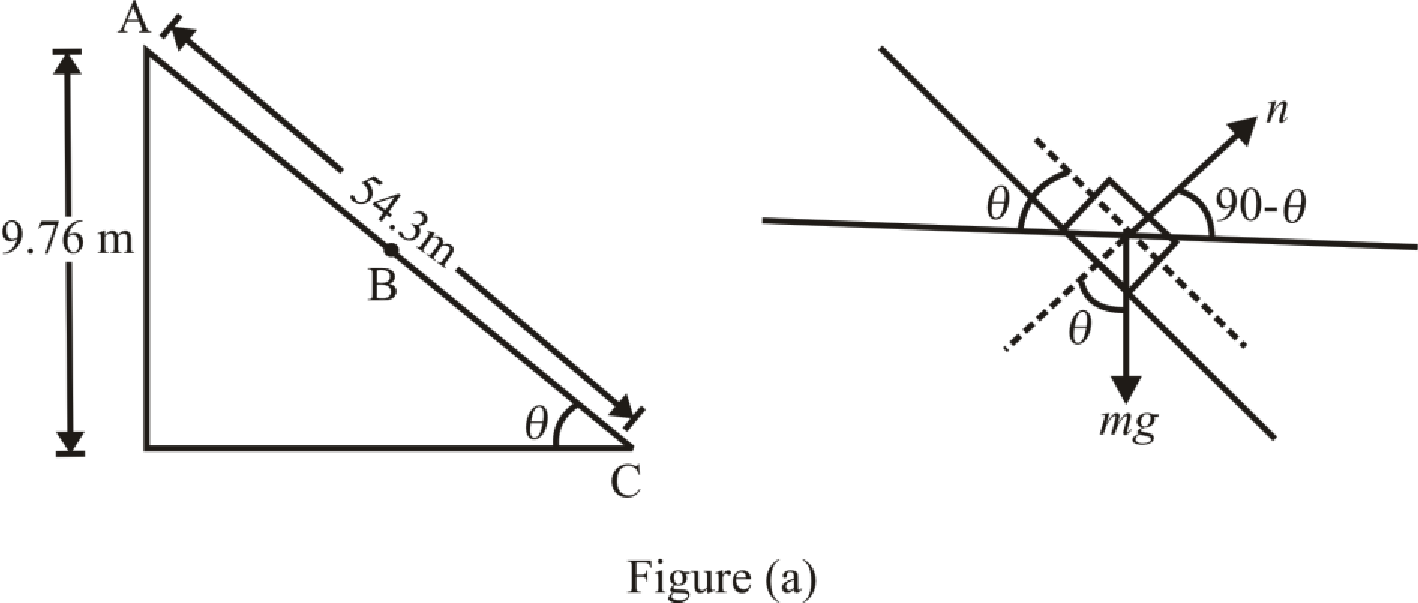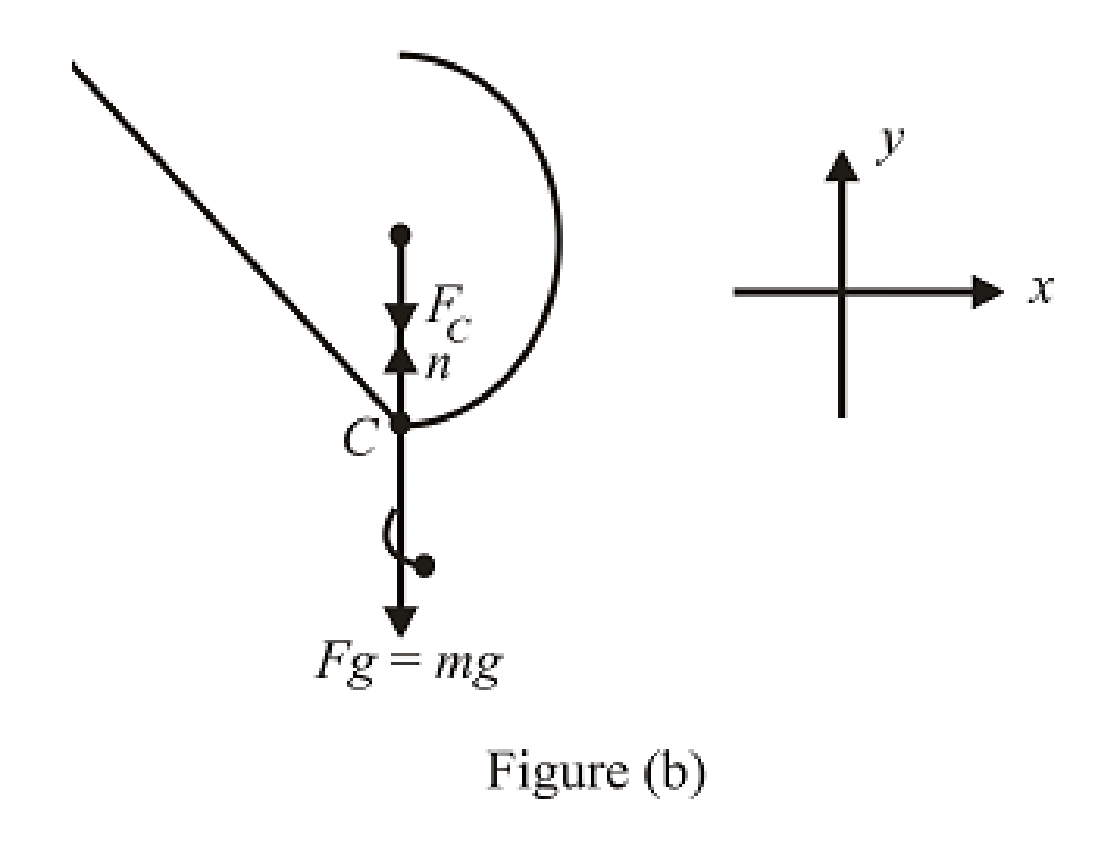
Concept explainers
(a)
The speed of the sled and rider at point C.
(a)
Answer to Problem 77AP
The speed of slader and rider at point C is
Explanation of Solution
Consider sled-chute-earth as an isolated system. Since, there is no friction force acting on the system.
Write the eqution for conservation of energy from point A to point C.
Write the equation for conservation of energy
Here,
Since, the system has potential energy due to gravitation of earth.
Write the equation for gravitational potential energy.
Here,
Write the expression for change in potential energy of the system.
Here,
Substitute
Simplify the above equation.
Here,
Since, the system has kinetic energy due to motion of sled and rider.
Write the equation for kinetic energy.
Here,
Write the expression for the change in kinetic energy.
Here,
Substitute
Simplify the above equation.
Here,
Substitute
Rearrange the above equation for
Conclusion:
Substitute
Thus, the speed of slader and rider at point C is
(b)
The magnitude of the total force the water exerts on the sled.
(b)
Answer to Problem 77AP
The magnitude of the total force the water exerts on the sled is
Explanation of Solution
Consider sled-water as a system.
Since, the friction force exerted by water is in retarding force and hence non-conservative force.
Write the equation for conservation of energy
Here,
Write the equation for work done by retarding force.
Here,
Substitute
Rearrange the above equation for
Simplify the above equation.
Since, the total force exerted by the water is friction force and normal force acting on the sled.
Write the equation for normal force
Here,
Write the expression for the magnitude of the total force
Here,
Since, the normal force and friction force are exerted in perpendicular direction.
Substitute
Simplify the above equation.
Conclusion:
Subsitute
Subsitute
Substitute
Thus, the magnitude of the total force the water exerts on the sled is
(c)
The magnitude of the force the chute exerts on the sled at point B.
(c)
Answer to Problem 77AP
The magnitude of the force the chute exerts on the sled at point B is
Explanation of Solution
Consider the sled on the chute at the point B as shown in figure (a).

Write the expression for the angle
Here,
Since, there is no motion in perpendicular direction fo the motion of sled, hence the net force at the point B will be zero.
Write the expression for net force in y-direction as shown in figure (I).
Here,
Conside the free body diagram of the sled and rider at point B.
Write the expression for net force.
Substitute
Rearrange the above equation for
Conclusion:
Substitute
Substitute
Thus, the magnitude of the force the chute exerts on the sled at point B is
(d)
The force exerted by the chute on the sled at point C where the chute is curving in the vertical plane.
(d)
Answer to Problem 77AP
The force exerted by the chute on the sled at point C where the chute is curving in the vertical plane is
Explanation of Solution
Consider the chute is curving in the vertical plane at point C.

The free body diagram of the sled at point C is as shown in figure (b).
Since, the sled has normal force and the centripital force is outward the center of curve.
Write the equation for net force at point C.
Here,
Substitute
Rearrange the above equation.
Conclusion:
Subsitute
Thus, the force exerted by the chute on the sled at point C where the chute is curving in the vertical plane is
Want to see more full solutions like this?
Chapter 8 Solutions
Bundle: Physics for Scientists and Engineers with Modern Physics, Loose-leaf Version, 9th + WebAssign Printed Access Card, Multi-Term
- A light, rigid rod is 77.0 cm long. Its top end is pivoted on a frictionless, horizontal axle. The rod hangs straight down at rest with a small, massive ball attached to its bottom end. You strike the ball, suddenly giving it a horizontal velocity so that it swings around in a full circle. What minimum speedat the bottom is required to make the ball go over the top of the circle? Answer : 5.49 m/sarrow_forwardThe figure shows a 100 g puck revolving in a 20 cm radius circle on a frictionless table. The string passes through a hole in the center of the table and is tied to two 200 g weights. The lower weight is a light bag filled with sand. Suppose a pin pokes a hole in the bag and the sand slowly leaks out while the puck is revolving. What will be the puck's speed after all of the sand is gone?arrow_forwardA string under a tension of 59.0 N is used to whirl a rock in a hortzontal circle of radius 2.45 m at a speed of 20.1 m/s on a frictionless surface as shown in the figure below. As the string is pulled in, the speed of the rock increases. When the string on the table is 1.00 m long and the speed of the rock is 50.5 m/s, the string breaks. What is the breaking strength, in newtons, of the string? Need Help?arrow_forward
- A 6kg hoop 3m in diameter rolls down from rest on a plane inclined 40 degrees. The height of the inclined plane is 2.5 m. At the bottom of the incline, how fast will it be moving forward when it reaches the bottom of the incline? A 2.5 m/s B 8.4 m/s C 4.95 m/s 6.3 m/sarrow_forwardA handful of professional skaters have taken a skateboard through an inverted loop in a full pipe. For a typical pipe with a diameter 13 feet, what is the minimum speed a 66 kg skater must have at the very top of the loop?arrow_forwardThe puck in the figure below has a mass of 0.120 kg. The distance of the puck from the center of rotation is originally 39.0 cm, and the puck is sliding with a speed of 80.0 cm/s. The string is pulled downward 18.0 cm through the hole in the frictionless table. Determine the work done on the puck. (Suggestion: Consider the change of kinetic energy.)arrow_forward
- Now Chandra and Darcel decide to try a problem. Suppose that the height of the incline is h = 16.0 m. Find the speed at the bottom for each of the following objects. solid sphere m/s spherical shell m/s hoop cylinder m/s m/s In a race, which object would win?arrow_forwardAn object of mass 15 kg is released from rest at the top of a frictionless "loop the loop" track. The loop has a radius of 6.7 m. What height, y, above the top of the loop should the object be released so that the object will just remain in contact with the track at the top? (Use g = 9.8m/s2 and round answer to 1 decimal place.)arrow_forwardA knight has an idea to break into a fortress by knocking a wall down with a rolling boulder. The plan is to roll the boulder from the top of a hill to hit the wall at the bottom of the hill. The boulder will need to have a speed of 15.0 m/s to break the wall. What is the minimum height the hill can have for the knight's plan to succeed? Assume the hill is frictionless and that the numerical answer you give is in meters.arrow_forward
- To test the speed of a bullet, you create a pendulum by attaching a 5.80 kg wooden block to the bottom of a 1.60 m long, 0.800 kg rod. The top of the rod is attached to a frictionless axle and is free to rotate about that point. You fire a 10 g bullet into the block, where it sticks, and the pendulum swings out to an angle of 39.0°. What was the speed of the bullet?arrow_forwardA cart of mass m= 303 kg is going around a circular loop-the-loop. There is no motor. The cart moves only under the influence of gravity. Ignore friction and let g = 9.8 meters per second squared. The loop has a radius of r = 18 meters. When the cart is at the top of the loop, the normal force on the cart (exerted by the track) pushes down on the cart with a force of N = 1,328 newtons. What is the speed of the cart (in meters per second) when it is at the bottom of the loop?arrow_forwardA 170-lb man carries a 20-lb can of paint up a helical staircase that encircles a silo with radius 30 ft. If the silo is 120 ft high and the man makes exactly four complete revolutions, how much work is done by the man against gravity in climbing to the top? Answer in ft-lbs.arrow_forward
 College PhysicsPhysicsISBN:9781305952300Author:Raymond A. Serway, Chris VuillePublisher:Cengage Learning
College PhysicsPhysicsISBN:9781305952300Author:Raymond A. Serway, Chris VuillePublisher:Cengage Learning University Physics (14th Edition)PhysicsISBN:9780133969290Author:Hugh D. Young, Roger A. FreedmanPublisher:PEARSON
University Physics (14th Edition)PhysicsISBN:9780133969290Author:Hugh D. Young, Roger A. FreedmanPublisher:PEARSON Introduction To Quantum MechanicsPhysicsISBN:9781107189638Author:Griffiths, David J., Schroeter, Darrell F.Publisher:Cambridge University Press
Introduction To Quantum MechanicsPhysicsISBN:9781107189638Author:Griffiths, David J., Schroeter, Darrell F.Publisher:Cambridge University Press Physics for Scientists and EngineersPhysicsISBN:9781337553278Author:Raymond A. Serway, John W. JewettPublisher:Cengage Learning
Physics for Scientists and EngineersPhysicsISBN:9781337553278Author:Raymond A. Serway, John W. JewettPublisher:Cengage Learning Lecture- Tutorials for Introductory AstronomyPhysicsISBN:9780321820464Author:Edward E. Prather, Tim P. Slater, Jeff P. Adams, Gina BrissendenPublisher:Addison-Wesley
Lecture- Tutorials for Introductory AstronomyPhysicsISBN:9780321820464Author:Edward E. Prather, Tim P. Slater, Jeff P. Adams, Gina BrissendenPublisher:Addison-Wesley College Physics: A Strategic Approach (4th Editio...PhysicsISBN:9780134609034Author:Randall D. Knight (Professor Emeritus), Brian Jones, Stuart FieldPublisher:PEARSON
College Physics: A Strategic Approach (4th Editio...PhysicsISBN:9780134609034Author:Randall D. Knight (Professor Emeritus), Brian Jones, Stuart FieldPublisher:PEARSON





